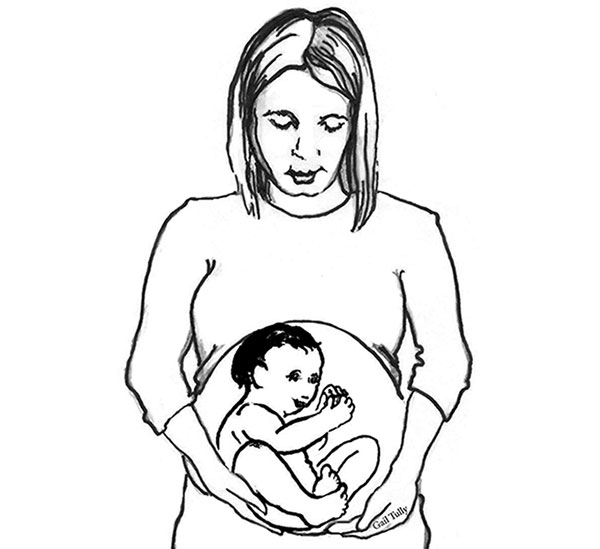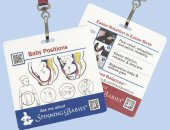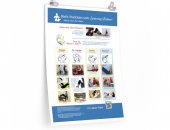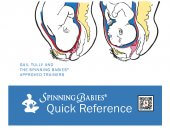Success is high with comprehensive body balancing
When any part of the pelvis is out of symmetry (crooked), then the ligaments supporting the womb are pulled and twisted too. The shape of the lower womb can be altered by this. The baby then has to find a way to fit that isn’t quite what nature intended. A twisted sacrum is common for breech (and posterior).
Aligning the pelvis and relaxing tight uterine ligaments attached to the fascia near the pelvis are why chiropractic adjustments can often help breech babies flip to a head-down position.
Continue body balancing at home and with professionals after the baby turns head down. One thing I’ve observed is that when the breech baby does flip head down during the last month or two of pregnancy, the baby often moves to the head down, posterior (face forward) position.
Why is Baby Breech?
A breech position may be caused by an imbalance (asymmetry) in the mother’s pelvis or soft tissues. In other words, a tension or a twist in the lower uterine segment may be a “soft tissue” issue. This is not the woman’s fault, as we simply live in an era where a slight twist in the pelvis is common. Some causes of this may be:
- Long car rides
- Crossing our legs
- Sports injuries
- Abrupt stops (fender benders, etc.) torquing our torso
- Carrying a toddler on a hip or other hip rotation causing activities over time
- Serious falls
- A neck or ankle injury
All of these can twist the pelvis and, in turn, twist the uterus, resulting in asymmetry. Many chiropractors can loosen the ligaments by doing the Webster Technique. Adjusting the sacrum, for both a vertical twist or a buckled (horizontal wrinkle) sacrum will let the baby put their head down more readily because the bones won’t be in the way. It may often take balancing muscles and ligaments (soft tissues) and the pelvic joint alignment (not one without the other) for success.
4 Steps For Turning a Breech Baby
If the baby is still breech after 30 or 32 weeks gestation:
- Do self-care exercises, like the Three BalancesSM and Daily Activities and the releases in our Techniques pages.
- Watch the Breech Consultation video below
- Try our comprehensive, 6-day plan in Helping a Breech Baby Turn ebook
- Seek professional help
Combine bodywork techniques with stretches on the Daily Activities page and, perhaps more importantly, the Weekly Activities page for a more comprehensive approach. Do the weekly activities every day for a week or two. Add Rest SmartSM but don’t expect your posture or that sitting up or lying on your left will turn baby itself.
Seek professional body work if you don’t get results after a week. After 34 weeks, call and book a session (or series of sessions) with someone who understands anatomy and fetal position, such as a Spinning Babies® Aware Practitioner or a chiropractor/osteopath with Webster certification.
Note: Body balance issues are common for breech presentation, but are not the only reason! We suggest our weekly activities on a daily basis when the baby is not head down. For video detail and more explanation, you may want to buy our Daily Essentials video for enhancing range of motion and suppleness. You can also attend a Parent Class in person, taught by one of our Spinning Babies® Certified Parent Educators.
These techniques are working for many who do them repeatedly, but be sure to ask your doctor if there is a medical reason you couldn’t try some of these suggestions. Each individual begins with their own level of need for balance. Some need a little help while others are overcoming twists or tightnesses that need just the right techniques.
At Spinning Babies®, we offer techniques that work for most pregnancies with a breech position. Your doctor or midwife can monitor your progress and give further suggestions for your particular situation.
Breech Consultation Video
Spinning Babies® creator Gail Tully shows a couple two types of inversions to do together for making room for their breech baby to turn head down or to make an external cephalic version easier for the doctor to perform.
Things to keep in mind:
- Breech fetal position is common before 30 weeks and often okay at 32 weeks.
- Trust your baby and trust your body, but let your body trust your habits too.
- You can begin general balancing activities without knowing fetal position.
- Do not use the Breech Tilt and Open-Knee-Chest in pregnancy unless you know baby is breech.
- Put yourself in the position you want your baby to be in—head down!
- Share your plan with your caregiver before you begin.
- Talk to your baby, heart to heart, and tell your baby what you want – and ask your baby what he/she needs in this situation too.
- When your womb is in balance, the baby is likely to flip head down spontaneously.
- If the baby is still breech at 37 weeks or later, you may receive medical advice to have an external cephalic version (ECV). Doing daily and weekly balancing activities before the ECV seems to help the procedure be more successful (and easier).
- Is one or both of your twins breech? Check out my article on twins.
When should I start?
- By 30-31 weeks, I highly recommend beginning the Forward-leaning Inversion position to encourage a head-down position.
- From 30 weeks on you can start the 6-day plan in our Helping Your Breech Baby Turn ebook.
- After 32-34 weeks, chiropractic adjustments are suggested.
- 34-35 weeks is the most successful time to use Moxibustion.
A detailed timeline is given for introducing techniques in pregnancies with breech babies. Look up your weeks gestation and do the suggestions for how to turn a breech baby listed there if you so choose. We have a handy exercise chart in our ebook as well.
Specific activities to try:

- Forward-leaning Inversion, 5-7 times once a day for 30 seconds each, about 15-120 minutes apart
- Follow the FLI with a Breech Tilt or Open Knee-Chest
- Side-lying Release on both sides for several minutes on each side (don’t do one side only)
- Listen to your baby! Ask the baby what they might need you to do to help them turn. Wait gently (not willfully) for an answer.
- Gently jiggling hips and sitz bones, thighs and buttocks
- Moxibustion (especially between 34-36 weeks) 2 times a day
- Stand on your head in a swimming pool (deep enough to cover your belly)
- Chiropractic Webster Maneuver and aligning the pubic symphysis (pubic bone)
- Maya abdominal massage and Rebozo Manteada (Sifting)
- Psoas Resolution
- Leg circles—these release areas of fibrous adhesion by moving the ball inside the leg socket. This is a gentle technique, traditional to Russia and rediscovered by soft tissue body workers today. (See the photo with Gail below for a variation on this.)
- Deep, circular mini massages between the rib and abdomen all along the edge of the front of the rib cage to loosen the superficial margin between the fascia around the rib cage, the respiratory diaphragm, and the peritoneum.
- Release tension with deep, circular massages along the margin from the hip to the top of the pubic bone on both sides.
- Do figure 8’s of the hips (as in belly dancing)
- Craniosacral therapy and myofascial release (more than the 3 releases I mention here)
- Hypnosis and/or journaling
- Loose ligaments may be supported by wearing a pregnancy belt (Add a belt if you have had several babies and now are carrying your baby in a breech position. Do the above techniques the same, but wear a belt afterward.)
These exercises may not work when:
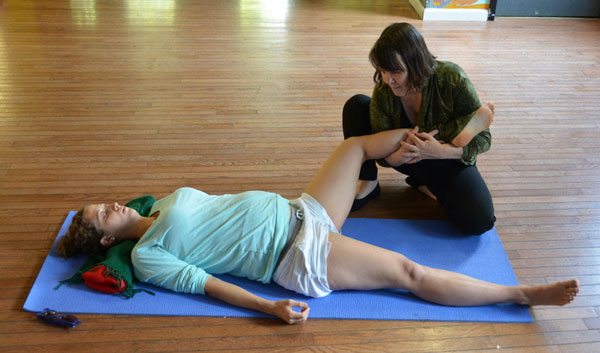
circles release minor adhesions in the leg socket and allow mobility in the connective tissue.
- The womb has a septum or unusual shape
- The baby is wrapped in a particular way by the cord (not as common as is claimed)
- If you’re having twins and one twin blocks the flipping movement of the breech twin
- Torsion causes reduced space in the lower uterine segment and it was not overcome or corrected by the woman’s selected activities (do more on the list above)
- There’s uncorrected torsion in the lower uterine segment (find another body worker)
- Intense core strength (6-pack belly)
Note: If you find that these exercises don’t work, it may increase emotional stress about having a breech birth. Whether or not the exercises work is not an indication of whether the vaginal breech birth will go smoothly or not.
Professional help for flipping a breech baby
For best success, begin professional help at 34 weeks. This opinion is shared by both Oxorn and Foote in Obstetrics Illustrated.
Professional help may include:
- Maya massage
- Chiropractic Webster Maneuver
- Chiropractic adjustment
- Therapeutic massage
- Homeopathy
- Acupuncture
- Fascial Therapy
- Craniosacral
- Hypnosis
- External cephalic version
You can see a list of professionals trained in our techniques in our Spinning Babies® Aware Practitioner listings.
After the baby turns
If your baby was breech and is now head down, you can stop the inversions for a few days. Walk briskly for a mile or more every day for three days to get the baby’s head into the pelvis. After three days of walking, resume Forward-leaning Inversion once a day and the Abdominal and standing releases to continue the balance that will help the baby stay head down and rotate more readily once labor begins.
How can I tell when the baby flips?
You may or may not notice when the baby turns. You might be able to tell if the breech flips by feeling the feet kick where the head had been before. Usually, the strongest kicks are from the legs (not the arms) and will be high in the womb when the head is low.
An anterior placenta (one that gets on the front of the womb) can block the baby’s limb movement and confuse people who are trying to tell the baby’s position. More often, a mother will notice a difference in how she is carrying the baby.
Notice where your baby is kicking. If it is quite different and is now strong at the top of your womb, you may want to stop measures to flip the baby. If it stays the same, you might want to continue until you can get the midwife or doctor to verify the baby’s position.
I offer an article on Breech Belly Mapping or you can buy the Belly Mapping® book.
What if I think my breech baby has flipped head down, but I’m not sure?
If you think the baby may have flipped head down, but you aren’t sure, you can either cease doing inversions until you do know for sure, or simply hold the Forward-leaning Inversion position for 30 seconds (or 3 long breaths).
If head down, will the baby flip breech if I do a Forward-leaning Inversion?
I think it’s unlikely that your baby will flip back to breech after balancing your body, unless the muscles and ligaments tighten up again. That said, keep your inversions short and do them only once a day. Don’t do the breech tilt if you think the baby may have gotten head down.
If you have a lot of amniotic fluid around your baby, so that a doctor needs to see you often, you should do other balancing activities like the Side-lying Release. Whether the baby flips on their own or with the help of an experienced midwife or doctor, the newly head-down baby is often in the right occiput posterior position.
A daily Forward-leaning Inversion can continue to help the baby get into an even better position for the start of labor. Remember, head down is only half the story!
If the breech baby doesn’t turn
Balancing techniques could help a vaginal breech birth go more smoothly. Always use physiologic breech birth practices (knee-elbow or hands-and-knees maternal position, hands-off the breech, natural childbirth, etc.).
Otherwise, a cesarean after labor begins gives the baby a bit of labor hormones to help transition into life outside the womb. Discuss these options with your midwife or doctor. There is currently better data in obstetrics to support physiological breech vaginal birth.
Consider that another week of healthy gestation, up to 40 weeks, has nothing but benefits for your baby. If you or your baby are not healthy, or if there is a prolapsed cord, you may need medical help.
Keep reading, keep balancing, and keep talking about what is beneficial for you and your baby with your provider. If you’d like to read more, here’s an article about the Window of Opportunity for Flipping Your Breech Baby.
Breech turning stories
VBAC-hopeful mama devotes a week to getting her baby head down
I just wanted to let you know that I appreciated your help, and that at 34 weeks, me, my chiropractor, and my midwife are all pretty sure that the baby has flipped head down, to what your site basically calls a LOT position. It was a week-long process that wasn’t complete until I had done 3 Webster appointments, plus a bunch of inversions and doing your “daily activities” on your DVD every day, but it seems to have worked!
-Rebekah B.
A doula helps avoid a cesarean
Hi Gail. I was in your workshop in Farmington Hills. I’m a doula from Windsor, Ontario, and I really wanted to let you know that I have a client who is now due in 10 days and her OB was threatening a c-section as the baby was malpositioned [Erin later said the baby was breech]. But after we did the exercises, inversions, and fascial releases, we were able to make room for the baby to move. As of the last ultrasound, the baby is head down, and now mom will be able to have the delivery she wanted. Thank you so much for sharing your techniques.
-Erin M Seguin RMT, Doula
I just found out my baby is breech
I received this email from a woman who found out her baby is breech. You can read my response to her below.
I recently found out my baby is breech. This is a 2nd baby. My first was a very calm baby and was always head down. This one is QUITE active and apparently flipped in the 4 days between my midwife appointment and an ultrasound (they thought my placenta was low… it’s ok).
I exercise 3-5 times a week. I eat well and am in good shape. I am seeing a chiropractor … Initially, saw her for “shifty hips” that would pop out of joint… hasn’t happened since.
My only pregnancy problem (with both) is uterine irritability… I’ve tried cramp bark tea for this but usually the only solution is to sit down. If I don’t nip it in the bud, it progresses to quite strong contractions where I vomit. My uterus is often quite tight for hours on end when I am walking around or at work (I’m a nurse). I was much worse with my son (they kept thinking it was preterm labor but my cervix never opened). Of note, he was a very quick and easy labor/ birth (less than 4 hours)– maybe from all the uterine toning?
Here are my questions:
- The Chiropractor did a Webster Maneuver once; usually she is cracking my back and neck and hips and such. Should she be doing Webster every week? What should I be expecting from her? I’ve never seen a Chiro before. I haven’t seen her yet since the baby flipped.
- How does my uterine irritability play into all this? My midwife said I had very good abdominal tone also. Is this hurting things?
- I’m being more diligent about my posture now and I’ll start some tilts/ inversions (already doing pelvic rocks). I’ll see if my husband can try the Rebozo sifting on me– would a Maya wrap sling work okay for a scarf?
- I plan to have a home/water birth with a CNM. I know she won’t do breech births at home. I’d be willing to give it a go if there was a practitioner. My mom and grandma were both easy birthers and I’m shaped like my grandma who popped 10 kids out on the farm ?
- Any other thoughts/suggestions? Thank you so much for your time. I better go do my pelvic rocks– the baby is dancing around in there!
Gail’s reply:
Your contraction symptoms and the baby’s breech position seem to match the picture of asymmetrical ligaments.
- The Webster Maneuver would help the round ligaments.
- Inversions will help the cervical ligaments first and then help the broad and round ligaments somewhat as well.
- Pelvic adjustment releases any possible pulls on the ligaments supporting the womb from even a slight misalignment of the pelvic joints.
- Get the abdomen ligaments relaxed and then supported. A pregnancy belt may help the looseness that makes it hard for the baby to have a toned slope to settle head down on.
- When a baby is breech, the first action is to relax a twist in the womb using the above methods.
Now see my answers to your five questions below.
Question 1: The Chiropractor may have to adjust the pelvis in three ways
Suggest your chiropractor check:
- The sacrum vertically (SI joints) for a twist at the ala
- The sacrum horizontally for a buckle (wrinkle) that a sacral release will undo
- The pubis symphysis
The Webster Maneuver is a gentle press on the round ligaments in a specific direction to soften the ligament. It takes just a few moments and will soften a cramp, spasm, or even “good tone” to allow the baby to flip past the ligaments into a head-down position. Releasing a kink or tightness in the round ligaments also helps the uterus become more symmetrical, which helps the baby into an ideal starting position for labor.
The Webster can be done repeatedly, weekly, or bi-weekly if in the last month or two. It is one step in helping a breech baby flip. Sometimes it is the only step needed, especially if repeated about 3-4 times. However, occasionally you may need more body work or self-care to flip a breech baby.
Question 2: Pelvic alignment and ligament release will help uterine irritability, especially getting the sacrum “unbuckled”
After a sacral release, you may wear a belt as much as possible to support a loose abdominal wall. There are other ways to help uterine “irritability” as well. Good tone may be too tight for a broad ligament. A tight broad ligament often goes along with an asymmetry in the round ligaments. Releasing it helps the baby turn past it.
Carol Phillips, DC, who taught me about the myofascial world, says that premature contractions are often solved by a sacral release (standing sacral release). The moms that I suggested to have this type of bodywork done have found it to work. I also suggest a high protein, whole foods diet with plenty of leafy greens, yellow veggies, Omega 3s, liquids, and salt-to-taste (basically a Brewer Diet and then some).
Question 3: Posture, inversions, and Rebozo
Using the Rest Smart℠ positions will be helpful, of course, but probably not enough to help the baby flip on his or her own after 32-34 weeks. However, you should have a clear idea of several things you can do yourself, and the body work that will help.
Continue with inversions. I suggest the method of getting upside down shown in the video demonstration on this page.
The Jiggle;, a Belly Hug; or Manteada with a Rebozo helps maintain the balance and releases tension in the abdomen. Traditional Midwives of Mexico, Central America and some South American countries use a Rebozo (a long woven cloth) helps relax the broad ligament if you can relax your belly into it like a hammock and your partner can lift the weight of the baby off your spine without scrunching into it. Start slowly and do short jiggles until your involuntary muscles can relax (about 3 minutes). Repeat daily as possible.
Traditional Russian midwives use a similar cloth in other ways to help balance the body.
Question 4: Finding an attendant for a vaginal breech birth
Your clarity on your ability to birth a breech baby is one of several aspects of safety for breech vaginal birth. An important physical assessment will help determine if a vaginal breech birth might be safe in your situation. Searching out an experienced midwife or physician in breech birth is a challenge, but a necessary one if you decide to have your baby naturally at home or in the hospital.
You will have to ask at midwifery circles, home birth support groups, cesarean prevention groups, and teaching hospitals for referrals. Having an experienced person reduces the risk of breech birth but doesn’t eliminate it altogether.
Question 5: Besides fascial therapy for uterine “irritability,” I suggest the following:
- Drink 3-4 cups of bulk red raspberry leaf tea daily (if you don’t have sensitivities to dried herbs, of course). Use 2 tablespoons in a wire mesh strainer and fill a quart jar with almost boiling water to steep for 5-6 minutes. Remove the herbs and drink hot or cold, and straight or with a splash of apple juice.
- Eat plenty of protein, but watch the peanut butter (it’s hard for a pregnant liver to process).
- Check for a calcium magnesium supplement that is easy to absorb.
- Wear a snug pregnancy belt.
Final thoughts on flipping a breech
The timing of body balance can allow baby to turn or be too late. Some will wait to try these techniques until they are already 34 weeks pregnant and for them, that may be too late. Others do one technique at 40 weeks and it works. How do you know which you will be?
Helping your baby flip head down is mostly a matter of finding what your womb needs for your baby, and listening to what your baby is telling you is needed in order to flip.
I believe you will do what your being feels comfortable doing. If not changing what you are doing is most comfortable to you, that’s ok. If exploring new activities, possibilities and people is comfortable, you will feel more ease in exploring your body and the balance this approach brings.
Think about a moment next year when you are looking back at this time. I hope you feel nurtured, bold, and proud of yourself for trying the things you felt were fine for you and in the amount of effort that was empowering to you.

